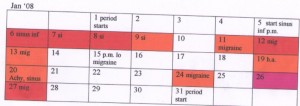 RSS FEED
RSS FEED
Posts Tagged ‘relaxation’
My Brain Hurts!
January 23rd, 2009
 Do you remember the Gumbies from Monty Python? “My Brain Hurts!” “Oh, no, Mr. Gumby…” “I’ve got a piece of brain stuck in my head and it hurts…” My cousin and I used to quote this at each other in our teens, and laugh hysterically (Mike can do a mean Mr. Gumby impression). Little did I know that a few decades later “my brain hurts” would become such a refrain for me!
Do you remember the Gumbies from Monty Python? “My Brain Hurts!” “Oh, no, Mr. Gumby…” “I’ve got a piece of brain stuck in my head and it hurts…” My cousin and I used to quote this at each other in our teens, and laugh hysterically (Mike can do a mean Mr. Gumby impression). Little did I know that a few decades later “my brain hurts” would become such a refrain for me!
I have never seen “thinking too hard” on any list of Migraine triggers, and I’m dubious about stress. As I’ve discussed here before, stress is officially considered an exacerbating factor in Migraine, not a trigger. So I don’t know whether the experience of “sparks are about to come out of my ears” has any physiological basis or not. Someday I may do some research and see what kind of scientific explanations there are for this phenomenon, but not today.
Today is a Friday. Fridays my brain has been working hard all week and I either give it the final push that sends it straight to Frigraine-land, or I get into an extended case of the sillies. I realize this is a tautology. I can’t tell you whether thinking too hard is a Migraine trigger because I can’t think that hard because that might trigger a Migraine. Does that make any sense? Probably not, but we’re going to have to live with it! Look I’ve been drafting an estate plan, researching corporate formation, reading up on the relaxation response, attending a mediation discussion meeting, giving a marketing talk, writing a migraine management newsletter, and trying to remember algebra. Among other things. If I think much harder my head will explode. I’m pretty sure of that.
A friend copied me on an email this week, introducing me to her disability lawyer, so that I can speak to the lawyer about her case. One of the things I am interested in is helping Migraineurs and others with invisible chronic illness to get disability income if they need it. Anyway, the friend closed the email by saying she was impressed at what a professional sounding letter she can still write, though it had given her a Migraine to do it! So I’m not the only one who finds that mental effort makes my brain hurt.
As I have gotten back into legal work lately, I have been using synapses in the ole brain-bucket that have  been in disuse for a number of years. I don’t know if the Migraines I’ve had over the past decades have any effect on my cognitive functioning, or if it’s just those darned decades themselves doing the job. I’ve been encouraged to discover that even though I can’t always think on my feet and recall immediately how to solve a problem, if I leave it alone and come back to it everything seems to fall back into place. I’ve done things I haven’t done in 10 years, things I haven’t done in 20 years, and this week had to dust off some math skills I haven’t used since high school!
been in disuse for a number of years. I don’t know if the Migraines I’ve had over the past decades have any effect on my cognitive functioning, or if it’s just those darned decades themselves doing the job. I’ve been encouraged to discover that even though I can’t always think on my feet and recall immediately how to solve a problem, if I leave it alone and come back to it everything seems to fall back into place. I’ve done things I haven’t done in 10 years, things I haven’t done in 20 years, and this week had to dust off some math skills I haven’t used since high school!
This is the good news, but there have been many panicked moments in between when I felt like my brain was short-circuiting, when I actually physically felt pressure mounting in my head, when I thought sparks were going to come out my ears. What is that? An over-active imagination? I don’t think so. I don’t have any studies to cite for you, but when I think my head is going to explode, I think it’s time to give the brain a break.
Right now my brain hurts. Just a little bit. I’m going to take a break after I write this, and do my relaxation breathing, then put on my boots and take a little walk in the melting snow. I may manage to avoid a Migraine tonight. I have to say I’m encouraged by the resiliency of this organ, this thinking organ that has been ailing, and aging, and working hard, that I need to earn my living and to see me through all the years of my life to come. I also need to remember that like any other part of me, I can exercise this brain, but it also needs its rest and relaxation, it needs both to stretch and to recover.
– Megan
There’s a piece of brain stuck in my head. Thank God!
Tags: brain, disability, migraine, relaxation
Posted in Managing, Rant, Silliness | Comments (4)
Relaxation for Migraineurs – A Cool Breeze Blowing Through your Brain
November 13th, 2008
BREESE – Breathe RElax Easy SmilE
(Yes, I know that’s not the right way to spell breeze.) I use the analogy of a breeze to learn to relax and disengage mental and emotional energy. In his book Breaking the Headache Cycle, neurologist Ian Livingstone, M.D. explains how our nervous systems need both a reasonable amount of stress, building the tone of the nervous system and keeping us growing, and a reasonable amount of relaxation, allowing the nervous system to rest and recover, and calm down.
Migraineurs are not necessarily more keyed up or more stressed than others (despite lingering myths about a “Migraine personality”), but our nervous systems are more sensitive to stimuli, and the higher our stress load, the lower our resistance to Migraine triggers. Dr. Livingstone cites research showing that Migraine frequency and severity can be reduced an average of 40% through regular practice of relaxation. A study at the University of Rajasthan, India, found that “Three months of intensive yoga practice—one hour, five days per week—curbs frequency and intensity of migraines by 70 percent,” according to Liz Somes in Psychology Today.
Imagine a soft gentle breeze blowing through our minds and bodies, carrying our stress away. We can generate the breeze through:
Breathe – We rarely breathe fully, but to breathe fully induces relaxation. In particular, we hold our inspiration and do not breathe out fully. One deep breathing practice is to breathe in deeply, to a count of three, and then breathe out completely, to a count of five.
Shortly after I started working with Dr. Livingstone I took on breathing like this for 10 – 15 minutes a day, and also any time I noticed myself getting anxious, tense or upset. Later that month I was driving to the airport for a business trip, cutting it rather close for my departure time, a situation which makes me very agitated. I noticed my stress level rising and the tension increasing in my hands, arms, shoulders, and neck. A few minutes later I had a tell-tale pinpoint of pain over my right temple. I began the 3 in – 5 out breathing practice and felt myself calming down. By the time I got to the airport half an hour later my head pain was gone.
RElax – Relaxation is a completely different state for our nervous systems than excitation. We need both states to be healthy. But many of us do not consciously and deliberately relax very often. Relaxation can occur in sleep, in meditation or visualization, in enjoyable conversation with a friend or loved one, in exercise or sexual activity, in reading or listening to music. Some of the activities we think of as relaxing – some computer or video games, for instance, actually excite us and raise our stress levels. I took on a daily practice of spending 15 minutes doing deep breathing, meditation and visualizations. Within a couple of months my migraine frequency was cut in half. When I stopped doing it regularly, within a couple of months the migraines had inched back up again.
Easy – give it up, let go, don’t worry! Stress and anxiety are real, physiological states. But they are also occurring in our minds, where we can notice them. I have taken on a practice of detachment with love, creative disengagement, stepping down. This becomes easier with a regular practice of meditation, where I can notice the things I need to let go of and picture myself dropping them.
SmilE – cultivate gratitude, humor and joy. This doesn’t mean you can’t gripe and vent when needed – but keep a commitment to do it in order to clear the bad stuff and regain your own optimism. Without gratitude, humor and joy, life is not worth living. When we smile it actually affects us physiologically, emotionally and mentally. Maybe you don’t want to smile – but try it anyway. You may say, “Megan, this just the power of positive thinking!” I won’t argue with you, but I will suggest that most of us spend most of our time submitting to the power of negative thinking! So try this for a change. Watch, read or listen to a gentle comedy. Look at something beautiful. Talk to someone you love. Play with a child. Find something to smile about.
If you practice generating the breeze, you can calm your system and reduce your Migraines. If you want to make it easier to practice, join us for the initial Free my Brain relaxation teleclasses. I will be leading a group in learning and practicing yoga breathing and full body relaxation, and guided visualization, in two 35 minute teleclasses, coming up on December 1st and 4th. Click here to read more or to register for the BREESE teleclasses.
– Megan Oltman
Grass in the breeze image courtesy of Andrew Storms.
Tags: breathing, Ian Livingstone, M.D., meditation, Migraine management, relaxation, yoga
Posted in Managing, Tips & Techniques | Comments (7)
Migraine Prevention – Early Success
November 12th, 2008
Shhh… I’m whispering so the Migraine monsters don’t hear me and punish me… Oh yeah, that’s kind 
of like believing in ghosts. But I seem to be having some success with the topamax I’m on for Migraine prevention. I have a Migraine this evening, but I’ve been running six to eight days between Migraines, for the last three or four weeks. For a year and more before that I had been getting several Migraines a week. So the frequency is cut in half, which makes a big difference. These are early results – I’ve had good 3 or 4 week stretches before, so I can’t predict whether this will continue. But I am hopeful!
I’m still on the minimum topamax dosage. I would have increased it several weeks ago but for a switch in insurance carriers making it necessary to delay the glaucoma test Dr. Gerhardstein wants me to have before increasing the dosage. Now I am happy we have taken it so slowly. Clearly my body has had a chance to acclimate itself to the medication. I am not experiencing any of the side effects I had in the first couple of weeks, either.
The biggest surprise to me is that I have more energy generally. I am not exhausted in the afternoon and evening; I feel motivated and I am getting more done. The constant low level of head pain I lived with most of the time is just gone – it seems to me that pain may have been responsible for a lot of my fatigue in the last year. The last two weekends I have done yardwork and projects around the house that I have wanted to do for ages.
 There is a downside, though. It’s very easy to start feeling like Wonder Woman in contrast with how I felt before. So once again I need to practice what I preach! Along with my clients, and you dear readers, I need to find that middle ground! For over five years now I have known that to have balance and well-being, to keep my energy up and my Migraines minimized, I need to pace myself. I need frequent breaks, and shifts in focus. I need time off in the middle of the day where I truly rest. I need to pay attention when I feel myself getting wired, when my blood pressure goes up, when I start moving and talking fast, when I feel the muscles in my forehead and scalp begin to contract. These are danger signs for me. Not least because I enjoy them – I like that edgy feeling of moving fast and powering through. But that energy is inevitably followed by a Migraine crash.
There is a downside, though. It’s very easy to start feeling like Wonder Woman in contrast with how I felt before. So once again I need to practice what I preach! Along with my clients, and you dear readers, I need to find that middle ground! For over five years now I have known that to have balance and well-being, to keep my energy up and my Migraines minimized, I need to pace myself. I need frequent breaks, and shifts in focus. I need time off in the middle of the day where I truly rest. I need to pay attention when I feel myself getting wired, when my blood pressure goes up, when I start moving and talking fast, when I feel the muscles in my forehead and scalp begin to contract. These are danger signs for me. Not least because I enjoy them – I like that edgy feeling of moving fast and powering through. But that energy is inevitably followed by a Migraine crash.
A few energy management tips:
- Take a break or shift your focus every 45 – 90 minutes. If you are at a computer get up, stretch and do something else for a few minutes.
- Take “green breaks” where you go outdoors, look outdoors through a window, look at a green plant, or at the very least look at a picture of a green plant. 2 – 5 minutes can make a huge difference.
- Take deep breaths to slow yourself down if you feel your energy or stress level mounting.
- Be sure to take a real break in the middle of the day – don’t work through lunch.
I failed at finding the middle ground today. I got a lot done, but there’s a price and I’m paying it. And so I learn my lesson again. I’m grateful to have more energy and less pain, and I’m committed to maintaining my energy by using it wisely! Let me know how you’re doing with your energy today!
– Megan
Tags: energy management, fatigue, Migraine preventive medication, relaxation, Topamax
Posted in Managing, Medicine | Comments (2)
Is the Economy Hurting your Head?
October 27th, 2008
As you know from my recent posts, the costs of health care and our national tragedy of a broken  health insurance system have been hitting me where I live lately. Of course I’m far from alone in this. In the current economic crisis, people are finding it harder than ever to afford the medications and health care they need. In a study published on October 14, the National Headache Foundation (NHF) surveyed 270 headache sufferers on line recently, and found that more than three quarters of the respondents said they have cut back financially, and those cuts have impacted their headache treatment:
health insurance system have been hitting me where I live lately. Of course I’m far from alone in this. In the current economic crisis, people are finding it harder than ever to afford the medications and health care they need. In a study published on October 14, the National Headache Foundation (NHF) surveyed 270 headache sufferers on line recently, and found that more than three quarters of the respondents said they have cut back financially, and those cuts have impacted their headache treatment:
Migraineurs are not alone in this, of course, the New York Times reported last week that prescription drug sales are down, and people are cutting back on life saving medications for many medical conditions. The NHF’s survey also found that people were cutting back on certain types of food purchases, and were not sleeping as well and feeling more stress due to their economic situation. Sleep disturbances, anxiety and dietary changes were all cited as triggering increased headaches. Delaying or skipping filling prescriptions, or using over the counter medications as a substitute is a serious concern. It’s easy for me to say to you – don’t cut back on prescription medications! Find something else to cut back on! If the choice is between snack foods and prescriptions, definitely give up the snack foods. Unfortunately, many of my prescriptions have a $50 co-pay. I could save a lot more money delaying a $50 co-pay than going without a $3.89 box of donuts. Sometimes we are faced with real, terrible choices. Sometimes we have to choose what to do without, and there may be no truly right answer. I will not presume to advise you here – you must make your own choice. Some economic insecurity is very real. Some people lose their jobs, can’t get loans, lose their investments, don’t have health insurance, and have to make terrible choices. Please ask yourself whether you really need to forgo this expense, or whether it is just anxiety and fear for the future that is making your decision for you. The NHF has some suggestions for ways to afford your prescriptions:
- If you are unable to afford your medication, many pharmaceutical companies offer patient assistance programs. Talk to your doctor or visit the NHF Web site (www.headaches.org) and click on Headache Education-Tools for Sufferers for a list of available programs.
- Talk to your doctor about your financial situation; there may be a generic form of your prescription available.
 Beyond the nuts and bolts of paying for the prescriptions, though, you need ways to manage your stress and anxiety. I suggest snuggling a kitty if you can. NHF has some good advice, picking up on some familiar themes here at Free my Brain, they suggest you practice relaxation techniques and include exercise in your daily routine. Suzanne Simons, NHF Executive Director, concludes with a great piece of advice: “remember that the financial turmoil we are currently experiencing is temporary. …[T]he situation will get better and keeping a positive outlook may help lessen the emotional and physical impact of these volatile economic times.” Remember that economies are affected by attitudes. Refuse to give in to despair. Do whatever you can to make things better. And get out and vote for change!
Beyond the nuts and bolts of paying for the prescriptions, though, you need ways to manage your stress and anxiety. I suggest snuggling a kitty if you can. NHF has some good advice, picking up on some familiar themes here at Free my Brain, they suggest you practice relaxation techniques and include exercise in your daily routine. Suzanne Simons, NHF Executive Director, concludes with a great piece of advice: “remember that the financial turmoil we are currently experiencing is temporary. …[T]he situation will get better and keeping a positive outlook may help lessen the emotional and physical impact of these volatile economic times.” Remember that economies are affected by attitudes. Refuse to give in to despair. Do whatever you can to make things better. And get out and vote for change!
– Megan Oltman
Hand on head image courtesy of Mr. Thomas/Christopher.
Tags: economy, migraine, National Headache Foundation, prescription drugs, relaxation
Posted in Communicating, Current Affairs, Managing, Medicine, Tips & Techniques | Comments (3)
Exercise for Migraine Prevention
June 19th, 2008
 When the wonderful May Migraine and Headache Blog Carnival came out on the topic, “How to integrate exercise into a life filled with migraines,” I was in the midst of my month and a half of viruses, flu and bronchitis, and having several migraines a week, and I couldn’t bring myself to write about exercise, let alone do it. So I submitted a post on Calming Down the Migraine Brain, with relaxation exercises, which are also a good thing!
When the wonderful May Migraine and Headache Blog Carnival came out on the topic, “How to integrate exercise into a life filled with migraines,” I was in the midst of my month and a half of viruses, flu and bronchitis, and having several migraines a week, and I couldn’t bring myself to write about exercise, let alone do it. So I submitted a post on Calming Down the Migraine Brain, with relaxation exercises, which are also a good thing!
Don’t get me wrong, I believe in regular exercise and I know I’m better off when I do it. There’s just a nasty chicken and egg dilemma when you are too sick to get moving. Another familiar dilemma for me is when I’m too stressed and worried to allow myself to drop everything and exercise, even though I know the exercise will reduce my stress and make me more effective at doing the stuff I’m worried about!
Sorry if the title was a bit of a come-on, I am not going to write a post today full of science on why exercise helps prevent migraines. I promise to pull the research together and write that post soon. Today I will give you an anecdotal, personal short-term success story.
It’s probably too soon to say this, but I have exercised every day for the last eight, and in that time I have had only one very mild migraine. Lately, this is big success for me as I have been having 5 –
8 migraines per month. Since I started recovering from the bronchitis, I’ve been walking every day, and stretching most days. Look at where I have to walk – right outside my door! The beautiful field does make it somewhat easier.
I know there are other factors: the weather has been mostly good; I have been taking it very easy as I have been recovering from being sick. I have really put my worries on hold and the stress level has been pretty low. How did I do that? I was too sick to even think, let alone worry, and I just gave myself over to recovering. I prayed a lot. I did my relaxation exercises when I had enough brain to focus on them. It probably didn’t hurt at all that Danny and I had just decided to let go of a business that was giving us enormous stress with very little return. I also have been almost entirely without caffeine – I didn’t want it
when I was sick and so I broke the habit and see no need to go back. I also know it has only been eight days – not a statistically significant sample!
Despite all of those factors, which surely contributed to calming my migraine brain, and the short time period, I think the exercise has been preventing migraines. It’s hard to describe, but I just have a sense of my system being calmer. I feel good! I started on the first day I felt well enough to even sit up out of bed – on that day I walked 7 minutes, at a geriatric pace. I have increased it every day. Eight days later I’m walking 45 minutes at a brisk pace.
While there’s not much evidence showing that exercise has a direct bearing on Migraine prevention, doctors remind us that regular exercise raises our endorphin levels, which makes us more resistant to pain.
Doctors tell us again and again we need to exercise and there’s tons of science behind it. But it’s hard to
remember that when my head hurts, or I’m exhausted or stressed out, or it’s blistering hot out. I’m planning to get the elliptical machine fixed for rainy or blistering hot days. I’m also planning to get up and out early before the heat settles in, or go out around sun-down. If you all would remind me, it would help over-ride my built-in forgetters.
– Megan
Let’s go for a walk!
Race Walk image courtesy of Kris Krug
Tags: exercise, migraine prevention, relaxation
Posted in Managing, Medicine, Weblogs | Comments (2)
More Time Management for Migraineurs: Managing the Time we Have
May 28th, 2008
Do try this at home. And at work. I wrote a post a while back on How do you Manage Life with Migraine?, about managing our time when migraines interrupt us all the time. Those of you receiving the newsletter got an expanded version of that post in the article “Time Management for Migraineurs (or, how can you get everything done when you can’t get anything done?).”
The gist of those pieces was that 1) whatever is on your list, you must learn to accept that you will never get it all done; 2) you need to choose what is most important to you and put those things in your schedule first; and 3) if you keep detailed lists of what you are working on, next steps, what you need to handle if you get sick, and what you need to care for yourself, you will best be able to pick up where you left off. I recommend Time Management from the Inside Out by Julie Morgenstern, as the best system I have come across for managing your time to make sure that you spend it on what is most important to you. And as I mentioned last week, Teri Robert has taken this idea of list-making and planning for Migraines much further in the helpful article MAPP Your Migraine!
All of that said, it occurred to me last week that I had left an important piece out. This may look like a blinding flash of the obvious, but it hit me that a key piece to making this all work is that we can only manage the time we have. Please don’t say “Duh” yet. Take a moment to let this sink in.
I read an intriguing post on How to Cope with Pain earlier this month, called Time Management and Pain. What intrigued me was that rather than laying out any nitty-gritty on scheduling and managing time, the article focused on “pacing ourselves and keeping stress to a minimum.” In other words, to manage time, we need to manage our own, often over-achieving and denial-ridden, selves!
We can only manage the time we have. I looked back over my Migraine and Wellness calendars for the last 5 years. I’m happy to say that my time spent incapacitated by Migraine and my other illnesses decreased over those 5 years from 27% of the time to 22% of the time. I have focused on increasing that
trend, with mixed results. I go up and down; there are months where I’m down more than I’m up. What I have not always remembered is that, however you slice it, I will be down for the count about 25% of the time.
When I look at a beautiful, clear, blank work week in my calendar, I can’t say, “Oh, goody, 50-60 working hours to schedule into!” Into that week I need to put all of the things that allow me to maintain my health, to pace myself and keep stress to a minimum. For me that includes exercise every day that I am capable of doing it. It includes 20 minutes of meditation or relaxation practice every day. It includes eating lunch away from my desk – taking breaks that are real breaks. And once I have put all those things in, that help me keep stress down and stay well, I still only have about 75% of the remaining time available for my work!
This means if I set deadlines for myself, I set them taking that
percentage of time into consideration. It means when I block out my
week, I leave blocks of “not working” time. It means when I come right
down to it, I have about 27 hours of productive working time that I can
count on in a week. Now I’m not a workplace productivity expert, but
I have worked in a lot of places, for others and for myself, and I
don’t think many people are really productive much more of their time
than that.
I have felt such freedom since I have been scheduling this way! My
productive time tends to be really productive; I stay focused on what
I’ve set out to accomplish in that time, knowing that I have a
reasonable
break coming. I can use my “not-working” time for those
water-cooler type conversations we tend to have at work, or for actual
work if I choose. Of course I can’t control that I will schedule my
migraines into the hours I have allotted, but there’s room in the
schedule to rearrange things when I do get sick. And when I am sick I
don’t worry about what’s not getting done. Without the added stress of
that worry, I can recover faster.
Since I am self-employed, I know I have more freedom around these issues than some of you who hold down “regular” jobs. But you can find ways to use these ideas. It may be about how you approach your time away from work. It may be about how you pace yourself at work. Please share your thoughts on managing the time you actually have!
– Megan
Tags: meditation, migraine, productivity, relaxation, stress management, time management
Posted in Managing, Tips & Techniques | Comments (2)
Migraine Management – My Other (other, other, other) Full Time Job
February 6th, 2008
A week or two ago I posted about living healthy – a few comments there got me thinking (again) about just how challenging this is. Getting it all right really does feel like a full-time job. It’s time-consuming-picky-detail-oriented, and doesn’t fit with the way most “normal” people live their lives. (By the way, I’m still interested in finding one of those “normal” people – if you spot one, let me know!)
This morning I am off to the doctor for a general health consult. I have a lot of questions for him and wanted to go in when I wasn’t feeling awful, for once, and would be more able to pay attention. I’m feeling okay today – not great but okay. Okay is good, I can live with it. So I have been preparing for the appointment: printing out the last 9 months of my “wellness calendar.” Here’s what January looked like: I color in days when I feel great as pink (when “I’m in the pink”) – I only had one of those. Days when I am sick but functioning are orange; when I am functioning about half-way are red; totally out for the count are brown. I had a very red and orange January, luckily no brown days.
feeling okay today – not great but okay. Okay is good, I can live with it. So I have been preparing for the appointment: printing out the last 9 months of my “wellness calendar.” Here’s what January looked like: I color in days when I feel great as pink (when “I’m in the pink”) – I only had one of those. Days when I am sick but functioning are orange; when I am functioning about half-way are red; totally out for the count are brown. I had a very red and orange January, luckily no brown days.
 So then I printed out the narrative part for the last month, that shows how much I slept, what changes I made to my diet, details of my migraines and sinus infections. I printed my checklists for caring for myself when I have a sinus infection or migraine, so the doctor can review them. I wrote out my questions. Here’s what my desk looks like right now. The yellow book in the pile is Breaking the Headache Cycle by Ian Livingstone, M.D. I don’t think messy desks are identified in there as a migraine trigger, but it still seems ironic!
So then I printed out the narrative part for the last month, that shows how much I slept, what changes I made to my diet, details of my migraines and sinus infections. I printed my checklists for caring for myself when I have a sinus infection or migraine, so the doctor can review them. I wrote out my questions. Here’s what my desk looks like right now. The yellow book in the pile is Breaking the Headache Cycle by Ian Livingstone, M.D. I don’t think messy desks are identified in there as a migraine trigger, but it still seems ironic!
I got up at 6:10 to get the kids’ breakfast and get the younger one off on the bus (the older gets herself off on the bus – let’s be clear about that). I dealt with dishes and then went back to sleep for 45 minutes since I’d had only 6 1/2 hours of sleep which is a pretty reliable migraine trigger for me. But when I got up again there was only time to prepare for the doctor and write to you here. So I have not done my meditation/relaxation practice for the day or gotten my exercise, both of which are important to keep myself healthy and resistant to migraine triggers. I’m going to have to fit them in this afternoon, when I will also be worrying about getting all my work done for the day. Stress alert!
I so want to be perfect at my treatment plan and know perfectly (!) well I’ve never been perfect at much of anything. It reminds me of one of those annoying parabolas (or was it a hyperbola?) from Trigonometry – approaching zero but never reaching it. The ridiculous emotional see-saw of trying to do it all but without stressing about it. Time for the Serenity Prayer again. Time for the rainbow picture again – the perfect rainbow over the field outside my window – reminding me of the return of hope. What would we do without it?
reminds me of one of those annoying parabolas (or was it a hyperbola?) from Trigonometry – approaching zero but never reaching it. The ridiculous emotional see-saw of trying to do it all but without stressing about it. Time for the Serenity Prayer again. Time for the rainbow picture again – the perfect rainbow over the field outside my window – reminding me of the return of hope. What would we do without it?
– Megan Oltman
Hurrying up without Being in a Hurry!
Tags: healthy living, Ian Livingstone MD, Migraine management, migraine treatment plan, relaxation, wellness calendar
Posted in Managing, Tips & Techniques | Comments (2)
Migraine Early Warning System
January 31st, 2008
One of the first things you learn when you started dealing with your migraines is to identify and avoid triggers. I learned this shortly after a murderous 5 day migraine I had in Arizona – I was at higher altitudes than I was used to, and there were forest fires all week, exposing me to lots of smoke. I was drinking way more coffee than usual to keep up with a busy vacation schedule with lots of driving. Voila – smoke + altitude + excess caffeine = nasty head-banging five day migraine.  For those of you living in Arizona – I don’t hold it against you or your state! It’s a beautiful corner of the world and I wish I had been able to visit with less pain. I saw Sedona in a migraine-fog – I understand it actually looks something like this:
For those of you living in Arizona – I don’t hold it against you or your state! It’s a beautiful corner of the world and I wish I had been able to visit with less pain. I saw Sedona in a migraine-fog – I understand it actually looks something like this:
Anyway this experience started me on an important inquiry – what are my triggers, and how can I avoid them?
There are common migraine triggers and then the ones that seem relatively unique to each of us. For one it’s eating dairy, drinking wine, for another flashing lights, particular smells, loud music, smoke, being startled, being in a crowd of loudly talking people, the bright packaging at the supermarket, the tv. It’s important to know what your migraine triggers are. If your brain is a loaded gun, ready to fire off with a migraine, and you know what pulls the trigger, that helps, right? You can avoid the triggering event or substance and reduce the likelihood that you’ll get a migraine.
Some lifestyle changes may be necessary to avoid triggers. Get into a regular sleep routine. Stop eating dairy. Stay away from places with flashing lights. Avoid smokers. (Just for instance. For a complete list of common triggers, visit mymigraineconnection here.) If you live with a smoker, you may need to an agreement that he or she won’t smoke in the house. If you smoke yourself, you may need to make a major change! If your kid’s hard rock music does it, you may need to have some rules around when and how loud it can be on. But some triggers are unavoidable, and we can’t avoid all of them all the time.
So I started asking myself – those may be the triggers, but what loaded the gun in the first place? By the way, it’s most unfair of me to be comparing our unique, sensitive and brilliant brains to guns. I hate guns. But we can’t deny the violence of the migraine. And even if you are a gun owner, I think we’d all agree that you’ve got to keep the thing unloaded around the house to avoid tragic accidents. So what loaded my migraine gun, and how can I keep it unloaded?
Migraine is a response to triggering stimuli. Current thinking is that stress itself is not a trigger but may predispose us to be more vulnerable to our triggers. You can read more about that here. For me, over-stimulation itself is enough of a stress to tip me over into migraine, even if I’m not aware of any other triggers. On some stereo speakers you can turn the volume way up, others you will blow out by  turning them up high. Our brains have the blow-out factor set way lower than the other 88 – 90% of the population. So, I say when we are stressed for a long period of time without relief, when we are highly stimulated without relief or let-down, we are loaded for migraine. We may have an ability to go into hyper-drive, to perform effectively, rapidly and intensely. But the more we do that, the more often and the longer duration, the more likely we are to load ourselves for a migraine explosion.
turning them up high. Our brains have the blow-out factor set way lower than the other 88 – 90% of the population. So, I say when we are stressed for a long period of time without relief, when we are highly stimulated without relief or let-down, we are loaded for migraine. We may have an ability to go into hyper-drive, to perform effectively, rapidly and intensely. But the more we do that, the more often and the longer duration, the more likely we are to load ourselves for a migraine explosion.
It takes more attention, more thought, more observation and introspection to determine your early warning signs than to determine your triggers. The good news is that if you do get attuned to them, you have a much higher likelihood of avoiding the migraine altogether. When I took on a daily relaxation practice, doing deep breathing and meditation to calm my system down every day, I reduced my migraines. When I got out of practice, the migraines started increasing again.
So what’s your early warning system? For me it’s a tightness in the shoulders and neck that moves up into my head. Also a sense of agitation – moving and thinking really fast. What are the signs for you that come before the triggers, the ones you have the best chance of diffusing? Please leave me a comment to let me know what you think.
a comment to let me know what you think.
(This is supposed to be a picture of your nervous system when it’s all calm and serene, but Thor looks like he’s ready to play. Imagine him curled in a furry purring ball.)
– Megan
Hoping you catch your signals before the guns go off
stereo speakers courtesy of Valerie Everett
Tags: altitude, caffeine, migraine prevention, Migraine triggers, relaxation, smoke
Posted in Managing, Tips & Techniques | Comments (3)
That disclaimer thing...
Remember: nothing we do here is medical advice or treatment or is a substitute for medical advice or treatment. Get competent medical advice to learn more about your migraines, possible treatments and risks.
What's New on Migraine Support Group Coaching |
Recent Comments
- on Calling all Redheaded Migraineurs
- on No, You’re not Crazy, You just Have Migraines
- on No, You’re not Crazy, You just Have Migraines
